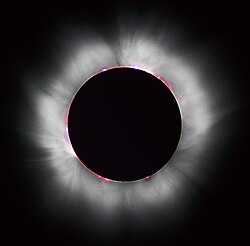| Total eclipse | |
 Total eclipse from Chita, Russia | |
| Gamma | 0.9183 |
|---|---|
| Magnitude | 1.042 |
| Maximum eclipse | |
| Duration | 170 s (2 min 50 s) |
| Coordinates | 57°48′N130°42′E / 57.8°N 130.7°E |
| Max. width of band | 356 km (221 mi) |
| Times (UTC) | |
| Greatest eclipse | 1:24:51 |
| References | |
| Saros | 120 (60 of 71) |
| Catalog # (SE5000) | 9501 |
A total solar eclipse occurred at the Moon's descending node of orbit between Saturday, March 8 and Sunday, March 9, 1997, [1] with a magnitude of 1.042. A solar eclipse occurs when the Moon passes between Earth and the Sun, thereby totally or partly obscuring the image of the Sun for a viewer on Earth. A total solar eclipse occurs when the Moon's apparent diameter is larger than the Sun's, blocking all direct sunlight, turning day into darkness. Totality occurs in a narrow path across Earth's surface, with the partial solar eclipse visible over a surrounding region thousands of kilometres wide. Occurring about 18.5 hours after perigee (on March 8, 1997, at 9:00 UTC), the Moon's apparent diameter was larger. [2]
Contents
- Unusual gravity variations
- Observations
- Russia
- China
- Eclipse timing
- Places experiencing total eclipse
- Places experiencing partial eclipse
- Eclipse details
- Eclipse season
- Related eclipses
- Eclipses in 1997
- Metonic
- Tzolkinex
- Half-Saros
- Tritos
- Solar Saros 120
- Inex
- Triad
- Solar eclipses of 1997–2000
- Saros 120
- Metonic series
- Tritos series
- Inex series
- See also
- Notes
- References
- External links
Totality was visible in eastern Russia, northern Mongolia, the northern tip of Xinjiang and Northeastern China and the eastern tip of Kazakhstan. A partial eclipse was visible for parts of Southeast Asia, East Asia, Alaska, and western Canada.

































































































